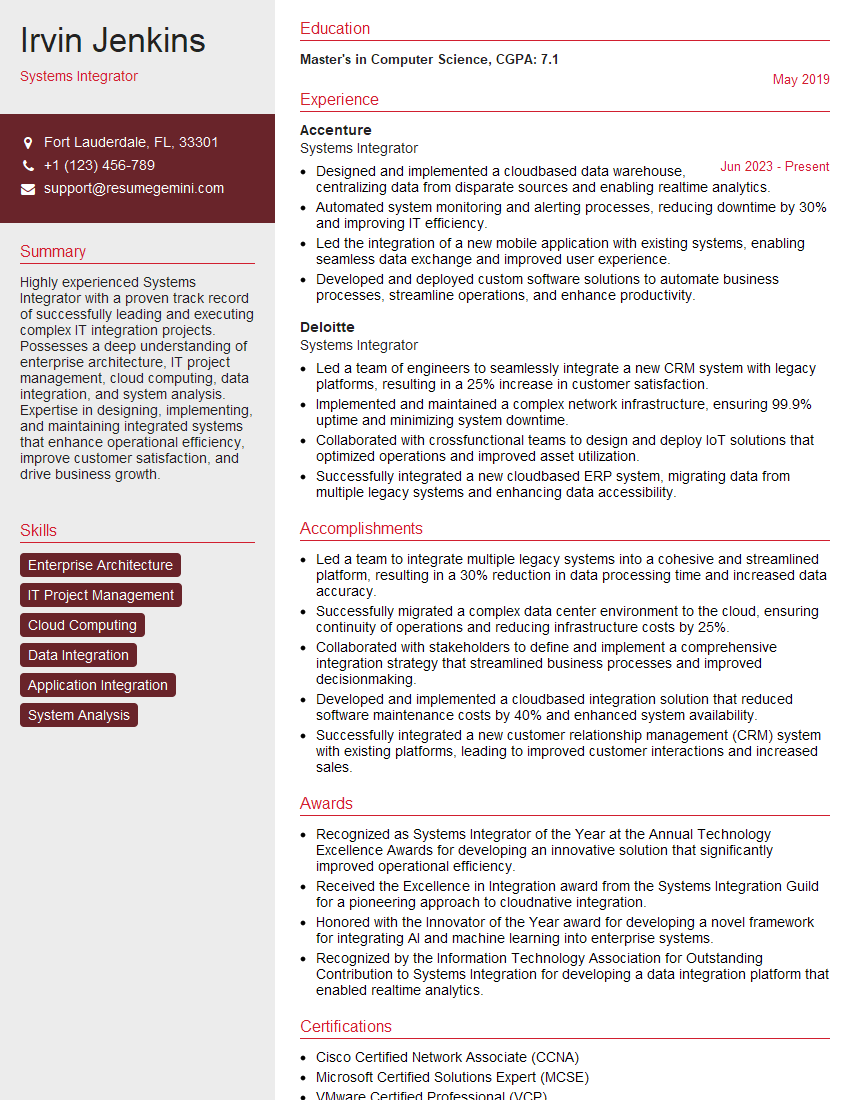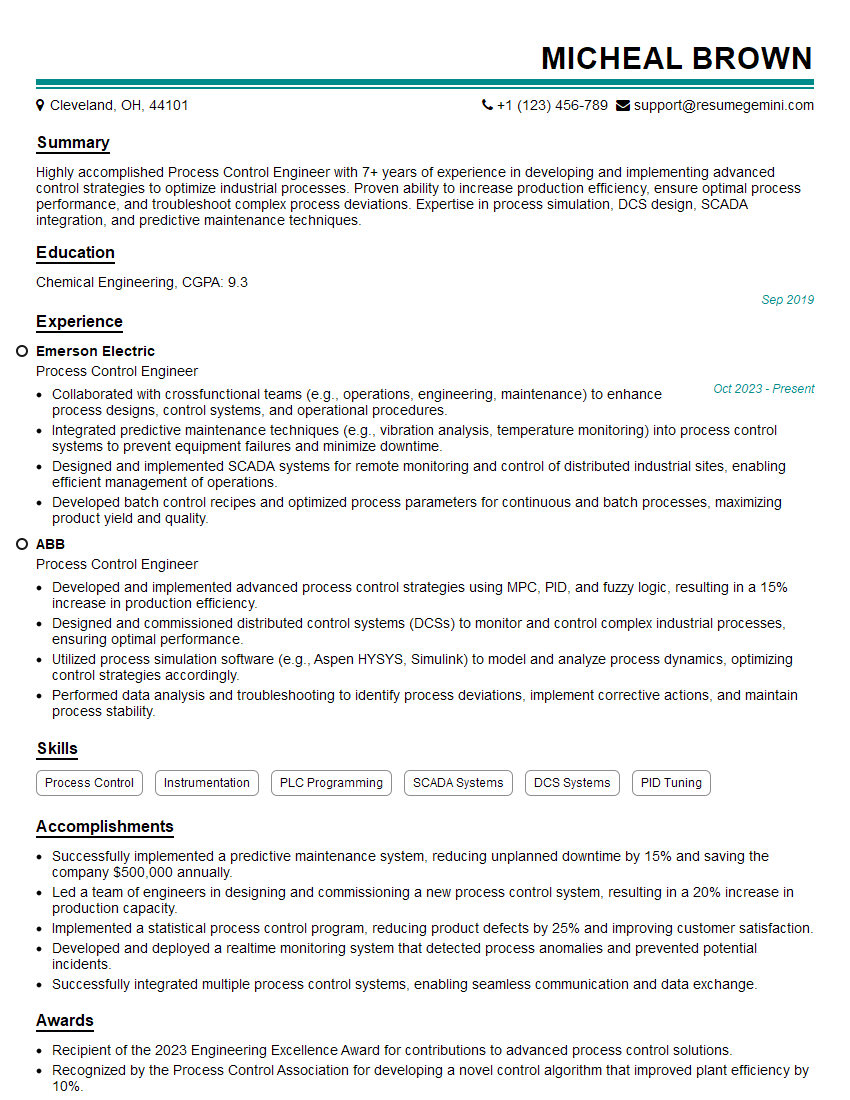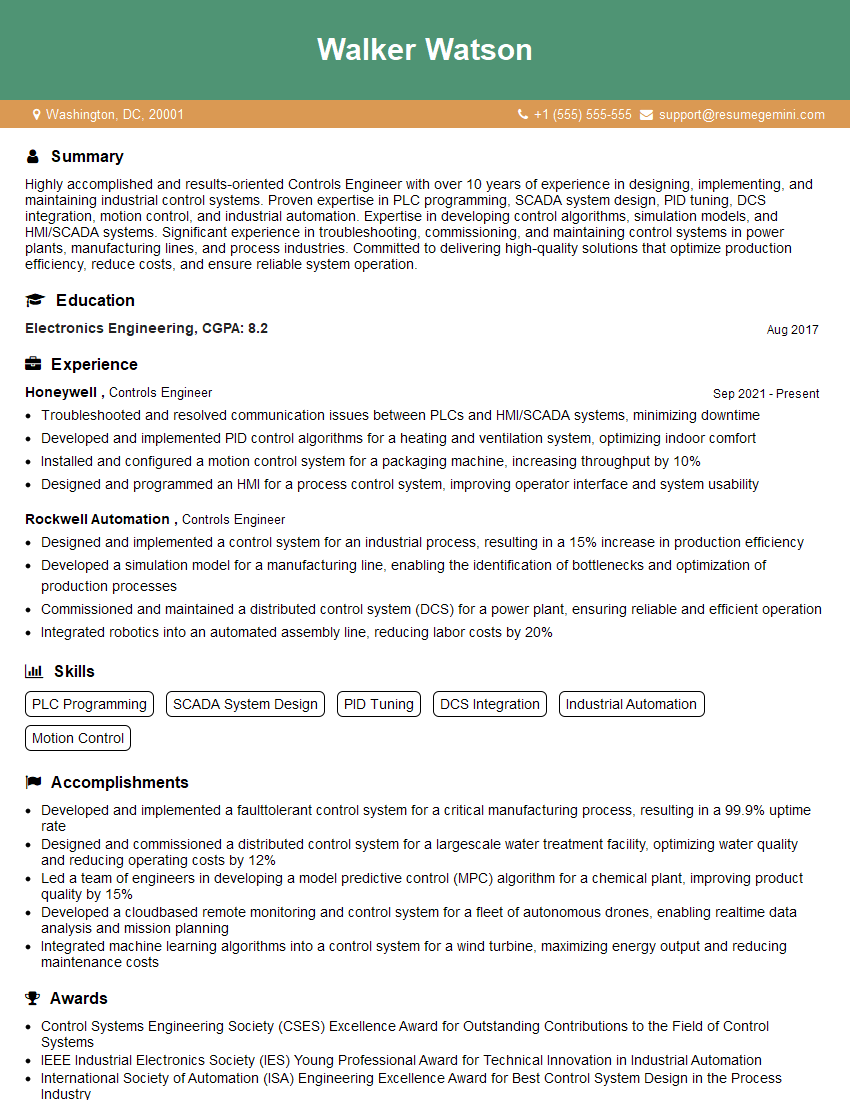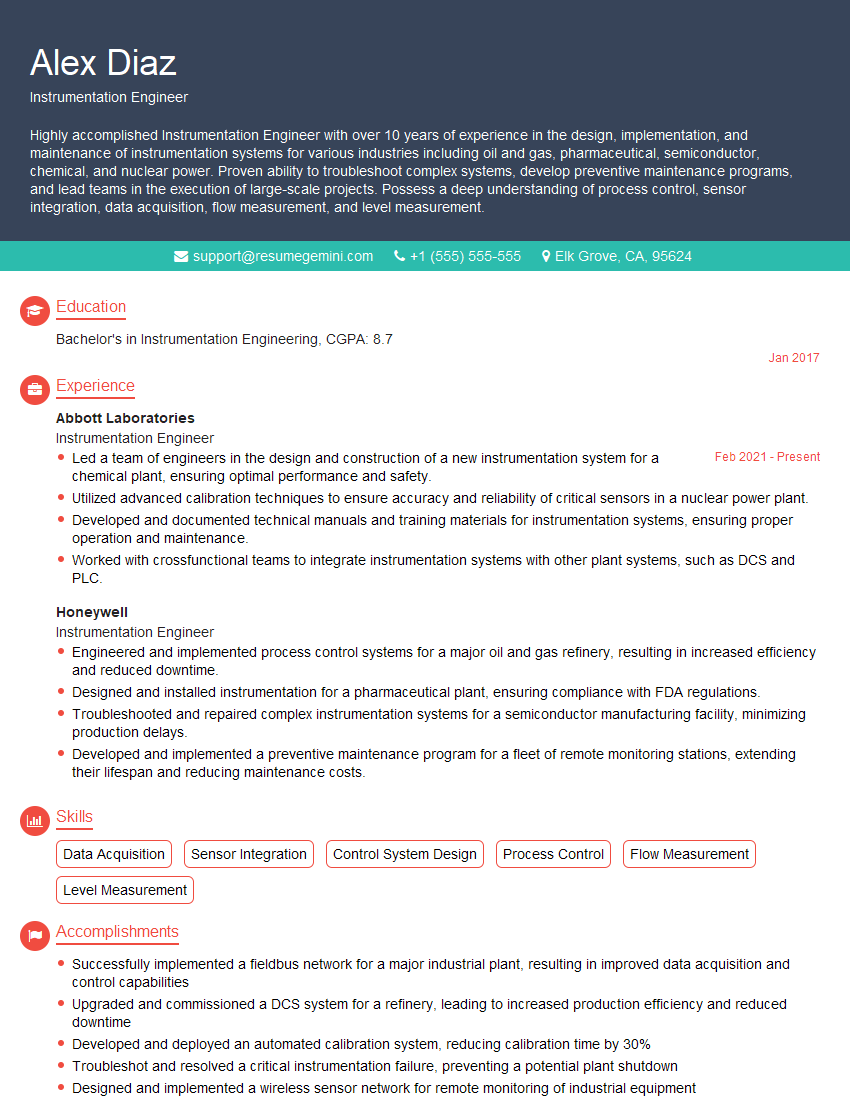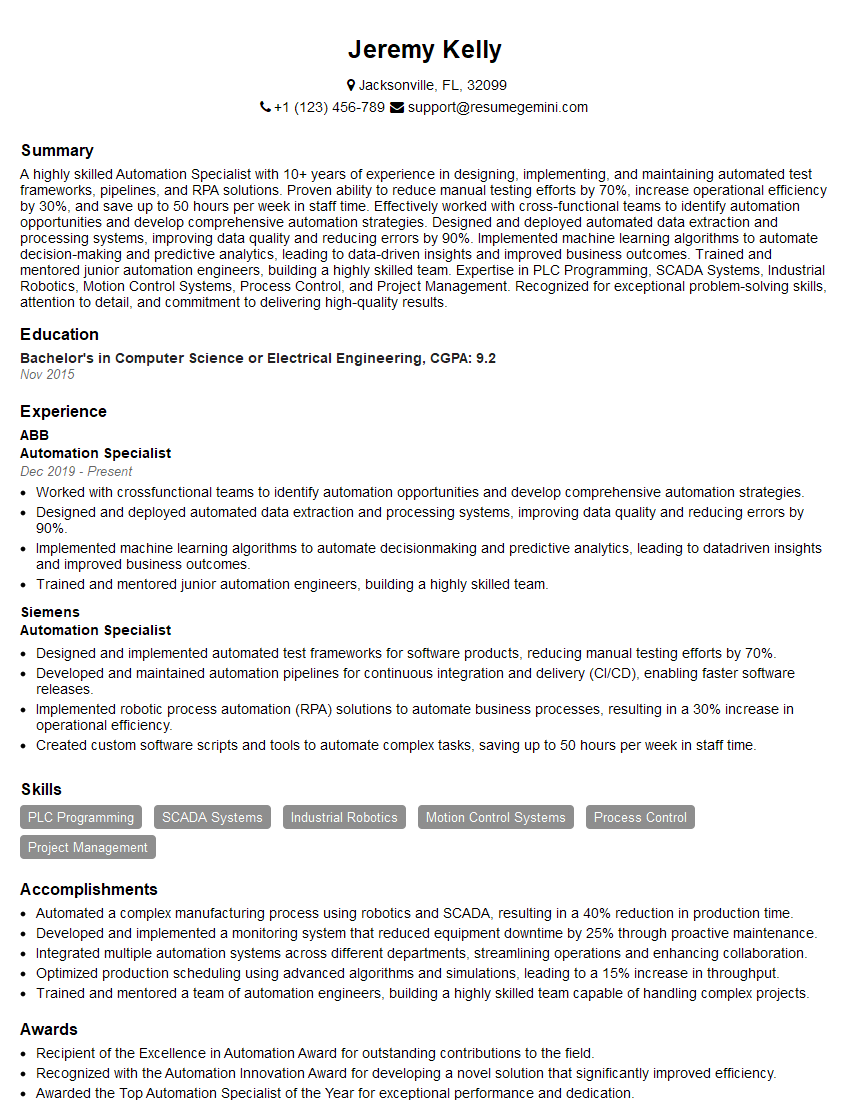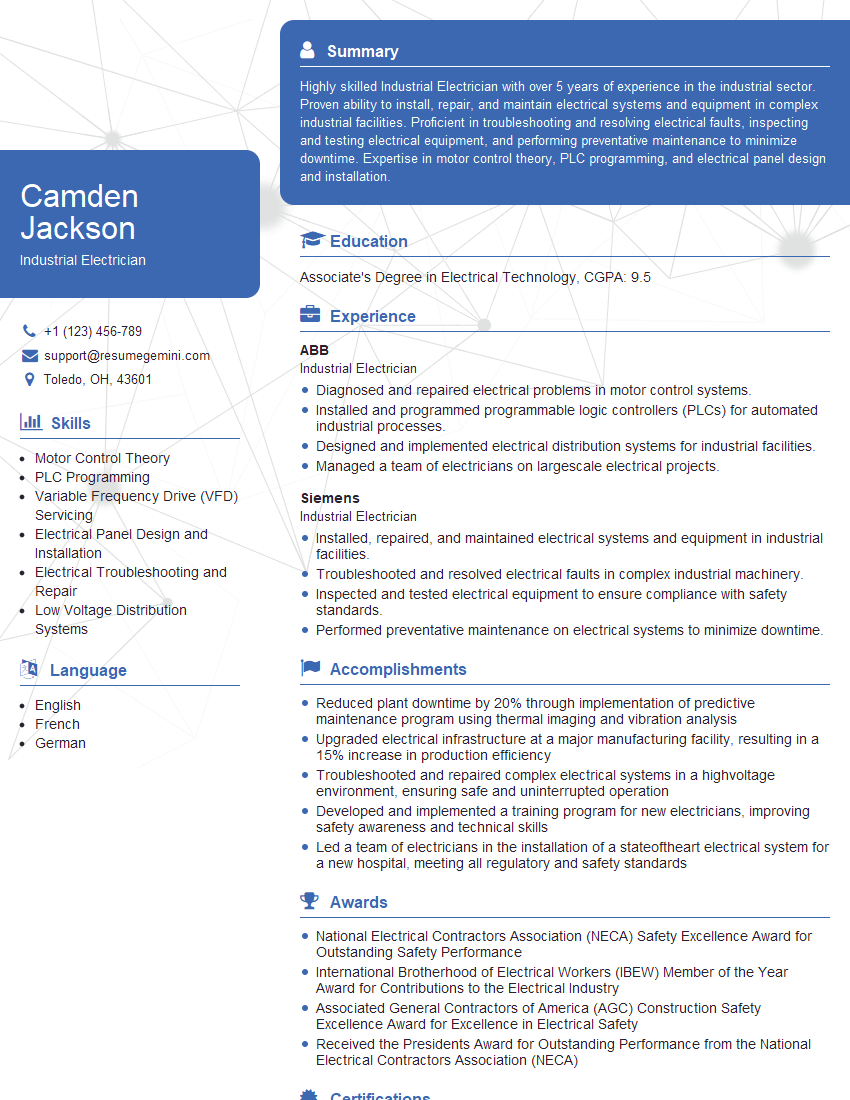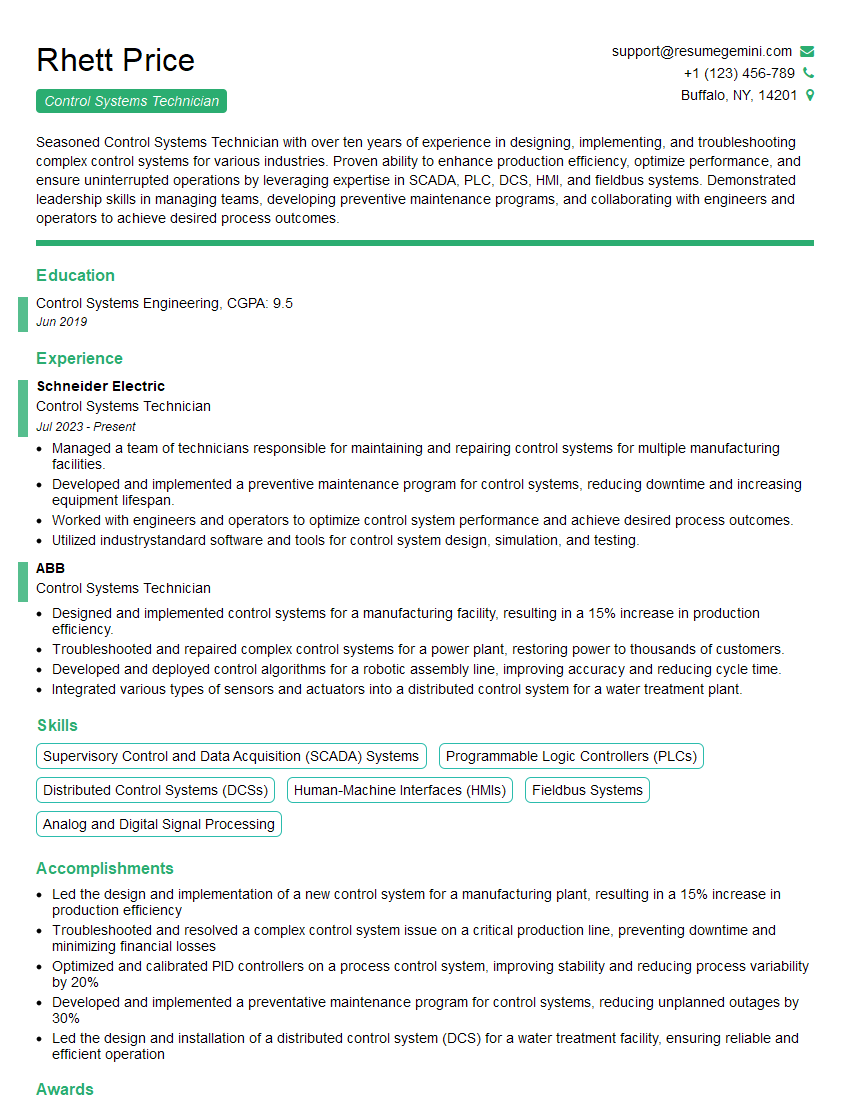The thought of an interview can be nerve-wracking, but the right preparation can make all the difference. Explore this comprehensive guide to Industrial Automation and Process Control interview questions and gain the confidence you need to showcase your abilities and secure the role.
Questions Asked in Industrial Automation and Process Control Interview
Q 1. Explain the difference between open-loop and closed-loop control systems.
The core difference between open-loop and closed-loop control systems lies in their feedback mechanisms. An open-loop system, also known as a feedforward system, operates without feedback. It simply executes a pre-determined sequence of actions based on the input signal. Think of a simple toaster: you set the time, it runs for that duration, and turns off – no sensor is monitoring the bread’s browning level. The output is entirely dependent on the input and the system’s inherent characteristics; there’s no correction for errors.
A closed-loop system, or feedback control system, incorporates feedback to regulate its output. A sensor measures the actual output and compares it to the desired setpoint. This difference, the error, is then used to adjust the input signal, ensuring the output remains as close as possible to the setpoint. Imagine a thermostat: it measures the room temperature and adjusts the heating or cooling accordingly until the desired temperature is reached. This continuous feedback loop allows for error correction and improved accuracy.
In industrial automation, closed-loop systems are far more prevalent due to their ability to maintain precise control and adapt to changing conditions. For example, a closed-loop system might be used to control the temperature of a chemical reaction, adjusting the heat input based on real-time temperature readings from a sensor. Open-loop systems are simpler but are typically used only when high precision is not required or when the environment is very predictable.
Q 2. Describe your experience with Programmable Logic Controllers (PLCs).
My experience with Programmable Logic Controllers (PLCs) spans over ten years, encompassing design, programming, troubleshooting, and maintenance across diverse industrial settings. I’ve worked extensively with various PLC brands, including Allen-Bradley (using RSLogix 5000), Siemens (TIA Portal), and Schneider Electric (Unity Pro). My proficiency includes ladder logic programming, structured text, function block diagrams, and sequential function charts. I’m comfortable working with both analog and digital I/O, implementing PID control algorithms for precise process control, and integrating PLCs with HMI (Human-Machine Interface) systems for operator interaction.
For example, I once developed a PLC program to automate a packaging line in a food processing plant. This involved coordinating conveyor belts, robotic arms, and labeling machines using precise timing sequences and error handling routines. I utilized Allen-Bradley PLCs, integrating various sensors for position detection, weight measurement, and product quality checks. The project demanded meticulous attention to detail to ensure efficiency and safety. I leveraged my understanding of industrial safety standards to design the PLC program to incorporate safety interlocks and emergency stop mechanisms.
Q 3. What are the different types of PLCs and their applications?
PLCs are categorized based on factors such as processing power, I/O capacity, and communication capabilities. Some common types include:
- Small PLCs: These are compact and cost-effective, suitable for smaller applications with limited I/O needs, such as simple machine control or small-scale automation projects.
- Mid-range PLCs: These offer more processing power and I/O capacity, ideal for medium-sized applications like production lines or packaging systems. They often incorporate advanced communication features for integration with SCADA systems and other industrial devices.
- Large PLCs: These are high-performance PLCs designed for complex, large-scale automation applications, such as those found in power plants, chemical processing facilities, and large manufacturing plants. They often handle a significant number of I/O points and feature advanced control algorithms.
- Safety PLCs: These PLCs are specifically designed for safety-critical applications, implementing safety functions to prevent accidents and protect personnel. They adhere to strict safety standards like IEC 61131-6.
The choice of PLC depends on the specific application’s demands. A small PLC would suffice for a simple machine, while a large PLC with safety features might be necessary for a hazardous environment.
Q 4. Explain your experience with Supervisory Control and Data Acquisition (SCADA) systems.
My SCADA experience involves designing, implementing, and maintaining SCADA systems for monitoring and controlling industrial processes. I’ve worked with various SCADA platforms, including Wonderware InTouch, Rockwell Automation FactoryTalk, and Siemens WinCC. My responsibilities have included designing the HMI screens, configuring data acquisition from PLCs and other field devices, creating alarm management systems, and generating historical data reports for analysis. I’m familiar with the importance of data security and implementing appropriate measures to protect sensitive industrial data.
In one project, I developed a SCADA system for a water treatment plant. The system monitored various parameters like water levels, chemical dosages, and flow rates, displaying real-time data on intuitive dashboards. I integrated the SCADA system with the plant’s PLCs and remote monitoring devices to provide comprehensive control and monitoring capabilities. The system also included alarm notifications for critical events and historical data logging for analysis and trend identification. This improved efficiency, reduced manual intervention, and enhanced operational safety.
Q 5. What are the common communication protocols used in industrial automation?
Industrial automation utilizes a range of communication protocols, each suited to specific needs. Some of the most common include:
- Profibus: A fieldbus protocol widely used in process automation, known for its robustness and real-time capabilities.
- Ethernet/IP: An industrial Ethernet protocol offering high bandwidth and flexibility, frequently used in factory automation environments.
- Profinet: Another industrial Ethernet protocol from Siemens, often found in larger, integrated automation systems.
- Modbus: A widely adopted serial communication protocol, simple and inexpensive, used for connecting PLCs and other devices.
- CAN bus: A high-speed serial bus protocol commonly used in automotive and other embedded systems, increasingly finding applications in industrial automation.
- OPC UA: (Open Platform Communications Unified Architecture) A platform-independent standard for industrial communication, providing interoperability between different systems and vendors.
The selection of a protocol depends on factors like required data rate, network topology, distance, and cost. Some systems utilize multiple protocols to accommodate different devices and sub-systems.
Q 6. Describe your experience with industrial networking (e.g., Ethernet/IP, Profibus).
I possess extensive experience in industrial networking, configuring and troubleshooting both Ethernet/IP and Profibus networks. With Ethernet/IP, I’ve designed and implemented networks for high-speed data transfer in automated manufacturing environments. This includes setting up network switches, configuring IP addresses, and troubleshooting network connectivity issues. I’m adept at configuring and managing network devices, ensuring robust and reliable communication between PLCs, HMIs, and other industrial equipment. My proficiency extends to utilizing network diagnostic tools to identify and rectify network faults.
My experience with Profibus involves working with various Profibus devices, understanding its master-slave architecture, and troubleshooting communication errors. I’ve utilized Profibus in applications requiring real-time communication and precise synchronization between devices, typically in process automation settings. This has involved configuring Profibus DP (Decentralized Peripherals) and Profibus PA (Process Automation) networks, addressing challenges associated with cable termination and signal integrity.
Q 7. How do you troubleshoot a faulty PLC program?
Troubleshooting a faulty PLC program requires a systematic approach. My strategy typically involves the following steps:
- Gather Information: Start by collecting all relevant information, including error messages, alarm logs, and descriptions of the problem. Talk to operators to understand the context of the fault.
- Inspect the Program: Carefully review the PLC program’s logic, checking for syntax errors, incorrect addressing, or timing issues. Use the PLC’s diagnostic tools to identify any internal errors or faults.
- Simulate and Test: Test the program section by section using simulation tools if available. This isolates potential problematic code segments. Verify the inputs and outputs of the PLC against expected values using a multimeter or other test equipment.
- Check I/O: Inspect all input and output signals to ensure that the sensors and actuators are functioning correctly. Use a multimeter to verify sensor readings and check for wiring faults.
- Utilize Monitoring Tools: Use PLC monitoring software to observe the program’s execution in real-time. Watch variable values and identify any unexpected behavior.
- Use Breakpoints (Debugging): Utilize the PLC’s debugging features to set breakpoints in the program code, allowing step-by-step execution to identify specific areas with errors.
- Examine Hardware: If software issues are ruled out, examine the PLC hardware for potential faults. Check power supply, CPU module, and I/O modules.
Example: If a conveyor belt isn’t starting, I’d first check the PLC program for instructions controlling the motor starter. Then, I would verify the sensor signal indicating the presence of product initiating the process. I’d also inspect the wiring to the motor starter and verify power supply to both the PLC and the motor itself. This methodical approach helps pinpoint the root cause efficiently.
Q 8. Explain your experience with HMI (Human-Machine Interface) design and programming.
HMI design and programming are crucial for creating intuitive and efficient interfaces between human operators and industrial automation systems. My experience encompasses the entire lifecycle, from requirements gathering and conceptual design to programming, testing, and deployment. I’m proficient in several HMI platforms, including Siemens WinCC, Rockwell FactoryTalk View SE, and Ignition.
For example, in a recent project involving a large-scale bottling plant, I designed an HMI that provided real-time visualization of the entire production process, including machine status, production rates, and quality control metrics. This involved creating custom screens with intuitive graphics and interactive elements to allow operators to monitor and control the process efficiently. I also implemented alarm management and reporting features, ensuring timely notification of any issues. The programming involved using scripting languages like VBA and Python to integrate the HMI with the underlying PLC system and databases for data logging and analysis. This resulted in a significant improvement in operator efficiency and reduced downtime.
Another project involved developing a mobile-friendly HMI for remote monitoring of a water treatment facility. This necessitated designing a responsive interface compatible with various screen sizes and incorporating secure remote access capabilities.
Q 9. What are the different types of sensors used in industrial automation and their applications?
Sensors are the fundamental building blocks of any industrial automation system, providing critical data about the process being controlled. Different sensor types are used depending on the specific application. Here are some common examples:
- Temperature Sensors: Thermocouples, RTDs (Resistance Temperature Detectors), and thermistors measure temperature. Applications include monitoring oven temperatures in a manufacturing process or regulating coolant temperature in a machining operation.
- Pressure Sensors: These measure pressure in various forms, including absolute, gauge, and differential pressure. Applications span diverse areas like monitoring hydraulic systems, pneumatic actuators, or gas pressure in pipelines.
- Flow Sensors: These devices measure the rate of fluid flow, such as liquid or gas. Examples include Coriolis flow meters, ultrasonic flow meters, and turbine flow meters used in chemical processing, water distribution, and oil and gas industries.
- Level Sensors: Used to measure the level of liquids or solids in tanks or containers, these sensors can be ultrasonic, capacitive, or based on pressure measurement. Applications include monitoring liquid levels in storage tanks or material levels in silos.
- Proximity Sensors: These sensors detect the presence of objects without physical contact, using technologies such as inductive, capacitive, or photoelectric principles. Common applications include object detection in robotic assembly lines or safety systems.
- Photoelectric Sensors: Detect the presence or absence of objects through light beams. They have wide use in automated inspection, part counting, and material handling systems.
The choice of sensor depends critically on factors like accuracy, range, response time, environmental conditions, and cost. Careful sensor selection is essential for optimal performance and reliability of the automation system.
Q 10. Explain your experience with PID controllers and tuning methods.
PID controllers are ubiquitous in industrial process control, providing an effective means for regulating process variables. They work by manipulating a control element (like a valve or motor) based on the error between the desired setpoint and the actual process value. My experience includes designing, implementing, and tuning PID controllers for a wide variety of applications.
PID stands for Proportional, Integral, and Derivative control. The proportional term provides immediate response to the error, the integral term addresses persistent offsets, and the derivative term anticipates future errors based on the rate of change. Tuning a PID controller involves adjusting these three parameters (Kp, Ki, Kd) to achieve optimal performance—a balance between speed of response, stability, and minimal overshoot.
I’ve used various tuning methods, including Ziegler-Nichols, Cohen-Coon, and Auto-tuning techniques. For example, in a recent project controlling the temperature of a chemical reactor, I employed the Ziegler-Nichols method to initially tune the PID controller. Then, I refined the tuning parameters through iterative adjustments based on real-time process response and performance data. This iterative approach is crucial to achieving optimal performance while minimizing oscillations and ensuring stability.
The process frequently involves using software tools that provide simulations or real-time analysis of the controller’s behavior, aiding in the identification and correction of tuning issues.
Q 11. Describe your experience with industrial safety standards (e.g., IEC 61131-3).
Safety is paramount in industrial automation, and adhering to relevant safety standards is non-negotiable. I have extensive experience working with IEC 61131-3, the international standard for programmable logic controllers (PLCs). This standard defines programming languages, data types, and communication protocols, aiming to ensure interoperability and safety. My familiarity extends beyond simply understanding the standard; it includes implementing its principles in practical applications.
For instance, in a recent project involving a robotic welding cell, I designed and programmed safety functions according to IEC 61131-3 guidelines. This included implementing emergency stops, light curtains, and interlocks to prevent accidents. The safety logic was rigorously tested and validated to ensure that it functioned correctly under various fault conditions. Proper documentation was essential to maintain compliance and traceability.
Beyond IEC 61131-3, I’m familiar with other relevant standards, including those related to machine safety (ISO 13849), functional safety (IEC 61508), and electrical safety. Understanding these standards is essential for designing and implementing safe and reliable automation systems.
Q 12. How do you ensure the reliability and maintainability of automation systems?
Ensuring reliability and maintainability is crucial for minimizing downtime and maximizing the return on investment in automation systems. My approach involves a multi-pronged strategy focused on proactive maintenance, robust design, and efficient diagnostics.
Robust Design: This starts with selecting high-quality components and employing fault-tolerant design principles. For example, using redundant components for critical systems can prevent catastrophic failures. Proper grounding and shielding are also essential for mitigating the risks of electrical noise and interference.
Proactive Maintenance: This includes implementing preventative maintenance schedules, including regular inspections, cleaning, and lubrication of machinery and components. Predictive maintenance techniques, using data analytics and sensor data to anticipate potential failures, are becoming increasingly important in this aspect.
Efficient Diagnostics: Implementing comprehensive diagnostics capabilities within the automation system allows for quick identification and resolution of faults. This might involve using error codes, logs, and alarm systems to pinpoint problems, thus minimizing downtime. Remote diagnostic capabilities can be particularly useful in geographically dispersed or hard-to-access sites.
Documentation: Thorough documentation is essential for maintaining and troubleshooting the system in the long run. This includes well-organized schematics, wiring diagrams, PLC programs with comments, and operating manuals.
Q 13. What are your experiences with different types of actuators (e.g., pneumatic, hydraulic, electric)?
Actuators are the ‘muscles’ of an automation system, converting control signals into physical motion. My experience spans the three major actuator types: pneumatic, hydraulic, and electric.
- Pneumatic Actuators: These use compressed air to generate force and motion. They are relatively simple, inexpensive, and safe in some applications, but can be less precise than other types. I’ve used them in applications like controlling valves in a pneumatic control system or powering grippers in a simple robotic system.
- Hydraulic Actuators: These use pressurized hydraulic fluid for high force applications. They offer high power density but are more complex and require specialized maintenance. I’ve worked with them in heavy machinery such as press brakes and injection molding machines where high forces are required.
- Electric Actuators: These utilize electric motors to generate motion and are commonly used in servo and stepper motor applications. They provide precise control and high speed, making them ideal for applications requiring fine positioning or fast response. I’ve extensively used them in robotic systems, automated assembly lines, and advanced process control applications requiring precise positioning and control.
The choice of actuator depends on factors like required force, speed, accuracy, environmental conditions, and cost. Understanding the strengths and limitations of each type is critical for effective system design.
Q 14. Explain your experience with robotics and robotic programming.
My experience with robotics encompasses both industrial robot programming and system integration. I’m proficient in several robot programming languages, including RAPID (ABB), KRL (KUKA), and others. This includes programming robots for a variety of tasks like welding, painting, material handling, and assembly.
For example, in a recent project, I programmed an ABB robot to perform a complex welding operation on automotive parts. This involved creating programs to precisely control the robot’s movements, speed, and welding parameters. I also implemented safety features to ensure the safety of personnel and equipment. This project involved careful consideration of the robot’s kinematics, work envelope, and path planning algorithms to achieve optimal performance and efficiency.
Beyond programming individual robots, my experience extends to integrating robots into larger automation systems. This involves coordinating the robot’s actions with other machines and peripherals, using communication protocols like Ethernet/IP, Profibus, or Modbus. I’ve worked with vision systems, PLC systems, and other peripherals to create sophisticated automated systems.
I’m also familiar with robot simulation software that allows for testing and optimization of robot programs before deployment, minimizing downtime and errors during the implementation phase.
Q 15. What are your experiences with vision systems in automation?
Vision systems are crucial in modern industrial automation, enabling robots and machines to ‘see’ and interpret their environment. My experience encompasses the entire lifecycle, from system selection and integration to calibration and ongoing maintenance. This includes working with various types of cameras (e.g., 2D, 3D, line scan), lighting techniques, and image processing algorithms.
For example, in a recent project involving automated part sorting, we employed a 2D vision system with a high-resolution camera and structured lighting to identify and classify parts based on their shape and orientation. We used a combination of edge detection and template matching algorithms to ensure accurate and reliable identification, even with variations in lighting or part positioning. The system was integrated with a robotic arm to pick and place the sorted parts into designated bins. Another project involved using 3D vision to inspect complex assemblies for defects, which provided a more robust solution than traditional 2D methods.
I’m proficient in using vision processing software like HALCON and OpenCV, and I have hands-on experience in selecting appropriate hardware, such as cameras, lenses, and lighting, based on application requirements. My expertise extends to optimizing system performance through careful calibration and algorithm tuning to minimize error rates and maximize throughput.
Career Expert Tips:
- Ace those interviews! Prepare effectively by reviewing the Top 50 Most Common Interview Questions on ResumeGemini.
- Navigate your job search with confidence! Explore a wide range of Career Tips on ResumeGemini. Learn about common challenges and recommendations to overcome them.
- Craft the perfect resume! Master the Art of Resume Writing with ResumeGemini’s guide. Showcase your unique qualifications and achievements effectively.
- Don’t miss out on holiday savings! Build your dream resume with ResumeGemini’s ATS optimized templates.
Q 16. How do you handle process variations and disturbances in a control system?
Handling process variations and disturbances is fundamental to effective process control. My approach involves a multi-faceted strategy that combines robust control algorithms, advanced process modeling, and proactive disturbance rejection techniques.
Firstly, I utilize feedback control loops with appropriate tuning methods (e.g., PID, Model Predictive Control) to maintain the process variables at their setpoints despite disturbances. For instance, in a chemical reactor, we might use a PID controller to regulate temperature by manipulating the flow rate of a heating medium. To account for anticipated disturbances, I’d often implement feedforward control, anticipating the effect of a disturbance and adjusting the manipulated variable preemptively. Imagine a change in feedstock composition – a feedforward controller would adjust the heating rate to compensate before the temperature drifts significantly.
Advanced techniques like Model Predictive Control (MPC) enable optimization of the control strategy over a prediction horizon, factoring in future disturbances and constraints. This is especially valuable in complex processes with multiple interacting variables. Finally, I utilize statistical process control (SPC) to monitor the process for variations and to identify and address the root causes of significant deviations from the norm. This proactive approach prevents small disturbances from escalating into larger problems.
Q 17. Describe your experience with data acquisition and analysis in industrial processes.
Data acquisition and analysis are critical for process optimization and troubleshooting. My experience involves designing and implementing data acquisition systems using various hardware and software tools. This includes using PLCs (Programmable Logic Controllers), SCADA (Supervisory Control and Data Acquisition) systems, and various sensors to collect real-time process data.
I’m proficient in using data historians and databases (e.g., historians like OSIsoft PI, databases like SQL Server) to store and manage large datasets. I employ advanced data analysis techniques, including statistical methods (e.g., regression analysis, time series analysis) and machine learning algorithms to identify trends, patterns, and anomalies in the data. This allows for early detection of potential problems, predictive maintenance, and optimized process performance. For example, in a manufacturing process, I used historical data to build a predictive model to predict machine failures and schedule preventive maintenance before significant downtime occurred. This resulted in significant cost savings and improved overall equipment effectiveness (OEE).
I’m also experienced in visualizing data using dashboards and reports to provide operators and engineers with clear insights into process performance. This ensures effective communication and decision-making based on real-time and historical data.
Q 18. What are your experiences with different control strategies (e.g., feedforward, feedback, cascade)?
Control strategies are the heart of any automation system, and I have extensive experience with various techniques, including feedback, feedforward, and cascade control.
Feedback control uses the error between the desired setpoint and the actual process variable to adjust the manipulated variable. A classic example is a thermostat, where the temperature difference between the setpoint and the actual room temperature dictates the heating or cooling action. Feedforward control anticipates disturbances and compensates before they affect the process variable. Imagine controlling the level of a tank – by measuring the inflow rate, a feedforward controller can adjust the outflow rate to prevent level deviations before they occur. Cascade control involves nested control loops, where the output of one controller serves as the setpoint for another. This is useful in complex processes requiring precise control over multiple variables. For instance, in a temperature control system, a primary loop might control the overall temperature, while a secondary loop controls the flow rate of a heating medium to achieve the desired temperature precisely.
My experience includes selecting and tuning controllers using various methods, like Ziegler-Nichols tuning and advanced optimization techniques. I understand the trade-offs between different control strategies and can select the best approach for a given application, considering factors like process dynamics, disturbances, and control system constraints.
Q 19. How do you ensure data integrity and security in an industrial automation system?
Data integrity and security are paramount in industrial automation systems. My approach focuses on implementing a multi-layered security strategy encompassing both physical and cybersecurity measures.
Data integrity is ensured through redundancy, data validation, and regular backups. We use techniques like checksums and parity checks to detect errors during data transmission and storage. Regular backups and version control safeguard against data loss. Cybersecurity measures include network segmentation, firewalls, intrusion detection systems, and access control mechanisms. We restrict access to critical systems based on the principle of least privilege, regularly update software and firmware, and conduct penetration testing to identify vulnerabilities. Strong password policies and multi-factor authentication further enhance security.
Furthermore, I adhere to relevant industry standards and best practices, such as ISA/IEC 62443, to ensure compliance and maintain a robust security posture. Regular security audits and training for personnel are also essential in maintaining a secure operational environment. Protecting the integrity and security of industrial automation systems is a continuous process requiring vigilance and proactive measures.
Q 20. Explain your experience with process simulation and modeling.
Process simulation and modeling are powerful tools for design, optimization, and troubleshooting. My experience includes developing models using various software packages like Aspen Plus, MATLAB/Simulink, and specialized process simulators. These models help to understand process behavior, predict performance under different operating conditions, and test control strategies before implementation in the real system.
For example, I’ve used dynamic simulation to optimize the control strategies for a complex chemical process, identifying the optimal tuning parameters for PID controllers and minimizing energy consumption. Steady-state simulation was utilized to design and size equipment, ensuring that the process operates within its design limits under various scenarios. Model predictive control (MPC) strategies often rely on process models for accurate predictions and optimization.
I also have experience in validating models by comparing simulation results with real-world data and refining the models based on any discrepancies. The accuracy of the model is critical, as it directly affects the reliability of the simulations and the effectiveness of the control strategies designed based on those models.
Q 21. What is your experience with industrial communication networks and cybersecurity?
Industrial communication networks are the backbone of modern automation systems, facilitating the exchange of data between various devices and systems. My experience spans a range of communication protocols, including Ethernet/IP, PROFINET, Modbus, and Profibus. I understand the architecture and functionality of these networks and am proficient in configuring and troubleshooting them.
Cybersecurity is a major concern within these networks. I’m familiar with implementing security measures such as firewalls, intrusion detection systems, and virtual private networks (VPNs) to protect against cyber threats. The use of secure protocols, regular software updates, and strong authentication mechanisms are all part of my standard practices. I also have experience working with industrial security standards, such as ISA/IEC 62443, to ensure that the networks are designed and operated securely.
In a recent project, we implemented a secure network segmentation strategy to isolate critical control systems from less critical networks, reducing the risk of a cyberattack impacting the entire operation. This includes using different network segments for various parts of the system, implementing firewalls and access control lists to restrict access, and regularly monitoring for unauthorized activity.
Q 22. Describe a challenging automation project you worked on and how you overcame it.
One of the most challenging projects I worked on involved automating a high-speed packaging line for a pharmaceutical company. The challenge stemmed from the stringent regulatory requirements for accuracy and traceability in the pharmaceutical industry, coupled with the need for extremely high throughput. The existing system was prone to frequent stoppages due to jams and inaccurate filling.
To overcome this, we implemented a multi-faceted approach. First, we conducted a thorough process analysis to identify bottlenecks and areas for improvement. This involved using process mapping techniques to visualize the entire packaging process and identify potential failure points. Second, we implemented a robust vision system to inspect the filled packages for accuracy and detect any defects in real-time. This system integrated with a PLC (Programmable Logic Controller) to trigger corrective actions, such as rejecting faulty packages or adjusting the filling mechanism. Third, we incorporated a sophisticated error-handling mechanism that could diagnose and rectify most issues autonomously, minimizing downtime. Finally, we implemented a comprehensive traceability system using RFID tags to track individual packages throughout the process, meeting regulatory requirements. The result was a significant reduction in downtime, improved accuracy, and enhanced overall efficiency. The project highlighted the importance of thorough planning, integrated systems design, and a robust error-handling strategy in complex automation projects.
Q 23. Explain your experience with different types of industrial drives (e.g., VFDs, servo drives).
I have extensive experience with various industrial drives, including Variable Frequency Drives (VFDs) and servo drives. VFDs are primarily used for controlling the speed of AC motors, providing smooth acceleration and deceleration, and precise speed regulation. I’ve used them in countless applications, from controlling conveyor belts and pumps to regulating the speed of fans and blowers in HVAC systems. For instance, in one project, we used VFDs to optimize the energy consumption of large industrial fans by dynamically adjusting their speed based on demand.
Servo drives, on the other hand, offer more precise control over motor position and velocity. They are ideal for applications requiring high accuracy and repeatability, such as robotics, machine tooling, and precision motion control systems. I’ve worked extensively with servo drives in robotic automation projects, where precise control of robotic arms is crucial for tasks like welding, painting, and assembly. I’m familiar with various communication protocols used with these drives, including Profibus, Ethernet/IP, and Modbus TCP, allowing for seamless integration into larger automation systems. My experience spans various drive manufacturers and technologies, giving me a comprehensive understanding of their capabilities and limitations.
Q 24. What is your experience with validation and verification of automation systems?
Validation and verification are critical aspects of ensuring the safety, reliability, and compliance of automation systems. Verification focuses on ensuring that the system is built correctly—that it meets the design specifications. This typically involves testing individual components and modules to verify their functionality. Validation, on the other hand, ensures that the system does what it is intended to do—that it meets the user’s needs and requirements. This involves testing the entire system as a whole to confirm its performance and compliance with standards.
My experience involves creating and executing both verification and validation plans, often using a combination of techniques like unit testing, integration testing, system testing, and user acceptance testing (UAT). For instance, in a recent project involving a safety-critical system, we employed rigorous testing methodologies, including fault injection testing and simulations, to verify the system’s response to various failure scenarios. We documented all testing activities meticulously, creating a comprehensive validation package to meet regulatory requirements and ensure the safety and reliability of the system. Generating detailed test reports and maintaining traceability throughout the entire validation process is critical in my approach.
Q 25. Describe your experience with the lifecycle of an automation project (from design to implementation).
The lifecycle of an automation project typically involves several phases:
- Requirements Gathering & Analysis: Defining the project scope, objectives, and user requirements. This often involves close collaboration with clients and end-users.
- Design & Engineering: Developing the system architecture, selecting hardware and software components, and creating detailed design specifications.
- Procurement & Fabrication: Sourcing and purchasing necessary equipment and materials. This involves careful vendor selection and managing the supply chain.
- Software Development & Testing: Developing, testing, and debugging the control software. This phase involves rigorous testing to ensure functionality and reliability.
- Commissioning & Integration: Installing and integrating the system on-site. This often involves working closely with electricians, technicians, and other contractors.
- Start-up & Validation: Testing and validating the fully integrated system to ensure it meets the requirements. This is where validation and verification efforts culminate.
- Training & Documentation: Providing training to operators and maintenance personnel, and creating comprehensive documentation for future reference and maintenance.
- Ongoing Support & Maintenance: Providing ongoing support and maintenance to address any issues or modifications needed post-implementation.
I have successfully managed projects through each of these phases, ensuring seamless transitions between stages and proactively addressing potential challenges.
Q 26. What programming languages are you proficient in for industrial automation?
I am proficient in several programming languages commonly used in industrial automation, including:
- Ladder Logic (IEC 61131-3): This is the most widely used programming language for PLCs, offering a graphical representation of control logic that is easy to understand and maintain.
- Structured Text (IEC 61131-3): A high-level text-based language that allows for more complex programming tasks and structured code. It is particularly useful for implementing advanced control algorithms.
- Function Block Diagram (IEC 61131-3): A graphical programming language that uses pre-defined function blocks to create control logic, allowing for modular and reusable code.
- C/C++: Often used for developing more complex software applications, such as HMI (Human Machine Interface) applications, and custom driver development for specialized hardware.
- Python: Increasingly used for data analysis, scripting, and integration with other systems in industrial automation environments.
My expertise extends to using these languages to develop robust, reliable, and efficient control systems, adapting my choice of language to the specific needs of the project.
Q 27. Explain your understanding of different control algorithms (e.g., Fuzzy Logic, Neural Networks).
I understand various control algorithms, including Fuzzy Logic and Neural Networks, and their applications in industrial automation.
Fuzzy Logic is a powerful tool for handling uncertainty and vagueness in control systems. Unlike traditional control systems that rely on crisp binary logic (true/false), fuzzy logic uses fuzzy sets to represent imprecise concepts like “high temperature” or “low pressure.” This allows for more robust and adaptable control strategies, particularly in systems with complex or ill-defined dynamics. For example, I used fuzzy logic to control a temperature control system in a chemical process where precise temperature regulation is crucial. The fuzzy logic controller adapted smoothly to changing conditions and maintained a stable temperature more effectively than a traditional PID controller.
Neural Networks are inspired by the structure and function of the human brain. They are capable of learning complex patterns from data and can be used for tasks such as predictive maintenance, fault diagnosis, and process optimization. I’ve employed neural networks to predict equipment failures in a manufacturing plant based on sensor data, enabling proactive maintenance and preventing costly downtime. The neural network was trained on historical data to identify patterns associated with equipment malfunctions. This allowed for early detection and scheduling of repairs before a complete failure occurred.
Q 28. How do you stay updated with the latest trends and technologies in industrial automation?
Staying updated in the rapidly evolving field of industrial automation requires a multifaceted approach. I actively engage in several strategies:
- Industry Publications and Conferences: I regularly read industry publications such as Control Engineering, Automation World, and ISA publications, and attend relevant conferences and trade shows to stay abreast of the latest advancements.
- Online Courses and Webinars: I take advantage of online learning platforms and participate in webinars hosted by industry experts and manufacturers to deepen my knowledge on specific technologies.
- Professional Organizations: Active membership in professional organizations, such as the ISA (International Society of Automation), provides access to valuable resources, networking opportunities, and industry insights.
- Networking with Colleagues and Peers: I maintain an active network with other professionals in the field through industry events and online forums, allowing for knowledge exchange and discussions on emerging trends.
- Hands-on Experience with New Technologies: Whenever possible, I seek opportunities to work with and implement new technologies in real-world projects, gaining firsthand experience and building my practical skills.
This holistic approach ensures I remain at the forefront of innovation in industrial automation, constantly adapting my skills and knowledge to address the challenges of this ever-changing landscape.
Key Topics to Learn for Industrial Automation and Process Control Interviews
- PLC Programming (Programmable Logic Controllers): Understand different PLC programming languages (e.g., Ladder Logic, Function Block Diagram), program development lifecycle, troubleshooting techniques, and best practices for efficient and reliable code.
- SCADA Systems (Supervisory Control and Data Acquisition): Learn about SCADA system architecture, HMI (Human-Machine Interface) design, data acquisition methods, alarm management, and report generation. Consider practical applications like monitoring and controlling a manufacturing process.
- Industrial Networks and Communication Protocols: Familiarize yourself with various industrial communication protocols (e.g., Profibus, Profinet, Ethernet/IP, Modbus) and their applications in different automation systems. Understand network topologies and troubleshooting network issues.
- Process Control Strategies: Grasp fundamental control strategies such as PID control, cascade control, feedforward control, and their applications in optimizing process parameters for efficiency and quality. Practice problem-solving scenarios involving process control loops.
- Industrial Sensors and Actuators: Develop a working knowledge of various sensor types (e.g., temperature, pressure, flow) and actuator technologies (e.g., valves, motors) used in automation systems. Understand their selection criteria and integration into control systems.
- Safety and Security in Industrial Automation: Learn about safety standards (e.g., IEC 61508, IEC 61511) and security measures to protect industrial control systems from cyber threats and ensure safe operation.
- Troubleshooting and Diagnostics: Develop strong analytical and problem-solving skills. Be prepared to discuss methodologies for identifying and resolving issues in industrial automation systems, using both theoretical knowledge and practical experience.
Next Steps
Mastering Industrial Automation and Process Control opens doors to exciting and rewarding career opportunities in a rapidly growing field. Your expertise in these areas will make you a highly sought-after candidate. To maximize your job prospects, it’s crucial to create a compelling and ATS-friendly resume that showcases your skills and experience effectively. ResumeGemini is a trusted resource that can help you build a professional and impactful resume. We offer examples of resumes tailored to Industrial Automation and Process Control to help you get started. Invest in crafting a resume that highlights your technical abilities and achievements; it’s your first impression to potential employers.
Explore more articles
Users Rating of Our Blogs
Share Your Experience
We value your feedback! Please rate our content and share your thoughts (optional).
What Readers Say About Our Blog
Hello,
We found issues with your domain’s email setup that may be sending your messages to spam or blocking them completely. InboxShield Mini shows you how to fix it in minutes — no tech skills required.
Scan your domain now for details: https://inboxshield-mini.com/
— Adam @ InboxShield Mini
Reply STOP to unsubscribe
Hi, are you owner of interviewgemini.com? What if I told you I could help you find extra time in your schedule, reconnect with leads you didn’t even realize you missed, and bring in more “I want to work with you” conversations, without increasing your ad spend or hiring a full-time employee?
All with a flexible, budget-friendly service that could easily pay for itself. Sounds good?
Would it be nice to jump on a quick 10-minute call so I can show you exactly how we make this work?
Best,
Hapei
Marketing Director
Hey, I know you’re the owner of interviewgemini.com. I’ll be quick.
Fundraising for your business is tough and time-consuming. We make it easier by guaranteeing two private investor meetings each month, for six months. No demos, no pitch events – just direct introductions to active investors matched to your startup.
If youR17;re raising, this could help you build real momentum. Want me to send more info?
Hi, I represent an SEO company that specialises in getting you AI citations and higher rankings on Google. I’d like to offer you a 100% free SEO audit for your website. Would you be interested?
Hi, I represent an SEO company that specialises in getting you AI citations and higher rankings on Google. I’d like to offer you a 100% free SEO audit for your website. Would you be interested?
good

